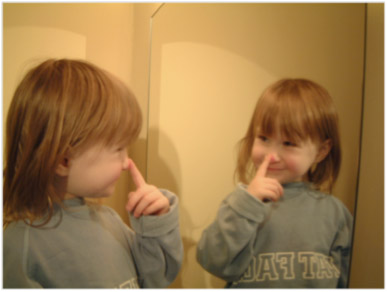After reading about Charles Darwin's observation that an orangutan did not seem to recognize itself in a mirror at the London zoo, the psychologist Gordon Gallup decided to test self-recognition in animals by placing a small red mark on their foreheads while they were asleep to see how they would respond when they awoke to see themselves in a mirror. Gallup found that many animals, including adult apes (but not all) could recognize themselves, since they tried to remove the makeup, but that other animals failed. Interestingly, other studies have shown that the animals that tend to pass the mirror test are those that live in social groups such as elephants and dolphins.
It is surprising then that human infants do not typically recognize themselves in the mirror test until well into their second year. If you surreptitiously place a mark on their nose, they don't touch it when they look in the mirror. They simply treat the baby in the mirror with a mark on its nose as another baby. This is why memory researchers argue that babies who fail the Gallup mirror test do not have self-recognition and so lack a sense of self. It is this sense of self that is so critical for forming an autobiographical memory of who we are. Otherwise, events are not related in a meaningful way and become sporadic, disconnected experiences lacking coherence. This is believed to be one of the reasons that explain infantile amnesia - our inability to remember much before our second or third birthday other than fleeting impressions.
However, infant psychologist Philippe Rochat argues that the mirror test in humans is actually a measure of being self-conscious about how one looks to others. He reasons that, before the second birthday infants are not that bothered with what they look like to others and so are not particularly concerned if they have a red mark on their nose. Somewhere around the second year, children are more concerned with their appearances and how they look to others.
This emerging vanity would explain the surprising finding that mirror self-recognition with the Gallup test is not universal around the world. In one study of Kenyan children between two and seven years of age, Rochat found that only 2 out of 104 children removed a sticker that had been secretly placed on their forehead when they looked in a mirror. Why? It cannot be that they do not have self-recognition in a mirror. They have seen and groomed themselves plenty of times in front of a mirror. Rather, Rochat argues that, unlike their Western counterparts, Kenyan children are not sure what to do in this unusual situation. They don't know whether they should remove a sticker from their forehead that must have been placed there by the strange Western scientist visiting the village. In a paper currently in press, Rochat and colleagues have shown that children are less likely to remove a sticker they discover when looking at the mirror in a situation where both the experimenter and their mothers have yellow post-it notes stuck to their foreheads. Clearly here children consider that wearing stickers must be normal adult behavior!
This notion of vanity is a fascinating twist on Gallup's self-recognition interpretation. It may be that passing the mirror test is not necessarily a measure of self-recognition, but rather a measure of embarrassment in the context of others. The mirror test reveals the point at which you become concerned by what others must be thinking about you - and from then on, I guess some of us cannot pass a mirror without checking out to see what we look like.